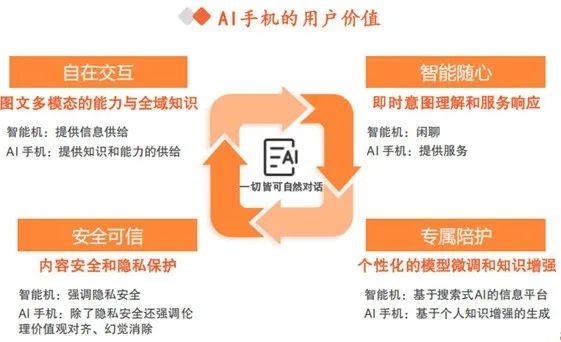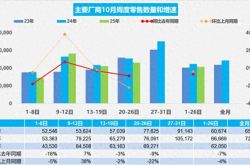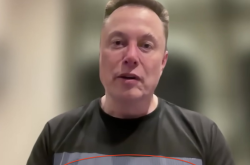AI + Mobile Phones: A Paradigm Shift and Ecosystem Reconstruction in the Industry (with Concept Stocks)
![]() 03/04 2025
03/04 2025
![]() 466
466
The global smartphone market stands at a historic juncture. According to IDC, shipments of AI-powered phones are projected to soar by 363% year-on-year in 2024, surpassing 234 million units, catalyzing the industry's recovery. This transformation, fueled by large AI models, is ushering the mobile phone industry from a focus on "parameter competition" to an era of "intelligent dimension upgrading."
Fundamentally, AI phones are not merely an amalgamation of features but a systemic reconfiguration encompassing chip architecture, interaction paradigms, and business models. This article delves into the underlying logic and investment opportunities of this revolution from three perspectives: market breakthroughs, value chain enhancements, and ecosystem competition and cooperation.
01. Breaking Through the Market Barrier: AI Redefines User Experience and Commercial Value
Since 2016, the global smartphone market has grappled with a "zero-sum game," where hardware innovations like foldable screens and advanced camera modules have yielded diminishing returns, prolonging consumer replacement cycles. This underscores the industry's collective anxiety over stagnation.
With generative AI integrated into devices, the smartphone industry is undergoing a revolutionary shift spearheaded by AI technology. Leading mobile phone manufacturers are actively exploring AI applications to secure a front-runner position in the new technological race.

For instance, Apple introduced "Apple Intelligence," Xiaomi launched "Super Xiao'ai," vivo debuted "Blue Heart Large Model," OPPO unveiled "AndesGPT," Honor introduced "Magic Large Model," and Huawei further cemented its dominance in deep AI and mobile phone integration with "Pangu Large Model."
This revolution not only redefines smartphone functionalities but also enriches user experiences with greater convenience.
This proactive AI push manifests across multiple levels:
Firstly, at the hardware level, manufacturers have introduced processors optimized for AI performance, such as Apple's A-series, Huawei's Kirin chips, and Qualcomm's Snapdragon series for Android devices. These chips continuously bolster AI computing capabilities to support complex algorithms and enhance on-device processing. Secondly, at the software level, vendors deeply integrate AI functions into their operating systems and user interfaces, including smart assistants, intelligent photography, and personalized recommendations, driving enhanced user experiences. Finally, in ecosystem development, mobile phone manufacturers strive to expand AI technology into smart homes, health monitoring, and AR/VR, fostering a comprehensive AI ecosystem.
With functional innovations, AI imparts new momentum to mobile phone manufacturers. IDC forecasts that by 2024, shipments of AI-enabled phones will exceed 234 million units, capturing a 19% global market share. By 2028, the share of generative AI phones is expected to rise to 54%, becoming the dominant mobile phone type.

02. Value Chain Enhancement: New Growth Avenues for Software and Hardware
Beyond mobile phone manufacturers, AI fosters new growth across the entire industry chain. Firstly, to meet mobile phone operational requirements, tech giants are developing or optimizing models to launch lightweight versions, enhancing user experiences and creating new growth opportunities.
Secondly, at the algorithm level, AI phones integrate dedicated processors like NPUs, significantly boosting performance and processing speeds in deep learning operations. This propels algorithm optimization and innovation in the industry chain.
Core hardware upgrades for AI phones center on SoCs and storage. Unlike traditional smartphones, AI phones prioritize SoCs and storage to run AI applications seamlessly. SoCs' computing power is crucial for deploying large models locally, directly impacting AI phone functionalities. Additionally, accessing and loading large models necessitate high-capacity, high-performance storage. MediaTek estimates that a 13-billion-parameter large model on a device requires a processor with 70 TOPS of computing power and 13GB of memory. Furthermore, AI tasks' high frequency and density set higher standards for components like heat dissipation, batteries, cameras, and PCBs.
In summary, the rise of AI phones not only leads the trend in new consumer electronics but also presents unprecedented innovation opportunities across the industry chain. AI technology paves the way for a more intelligent and efficient era in consumer electronics.
Therefore, AI phones are poised to become the new inflection point for mobile phone replacements post-5G, and related industry chain companies stand to benefit. Key players to watch include Luxshare Precision, Longsys Electronics, Pegatron, DBS Precision, Lens Technology, L&P Precision, GoerTek, Sunlord Electronics, Universal Scientific Industrial, and DEMIN.
03. Ecosystem Competition and Cooperation: From "Function Wars" to "AI Agent Competition"
As mobile phones evolve from "tools" to "intelligent agents," industry competition transcends hardware parameters. IDC predicts that by 2028, AI phones will capture 54% of the global market, generating over $200 billion in new value.
This impact will unfold in three stages: "hardware innovation - scenario reconstruction - ecosystem monopoly." At the hardware level, NPU computing power will exceed 100 TOPS, with continuous advancements in heat dissipation and energy efficiency. At the scenario level, AI assistants will shift from "passive response" to "active service," encompassing verticals like healthcare and education. At the ecosystem level, operating systems will deeply integrate AI capabilities, dismantling application silos and enabling seamless cross-device collaboration.
Previously, as smartphone shipments peaked, so did their perceived development. New models mainly featured new colors, larger/multiple lenses, more memory, and better CPUs. AI's emergence provides a new direction for smartphone innovation: true intelligent agent mobile phones.
In such phones, AI transcends being a mere function; it becomes a new operating system interconnecting the phone's data and operations.
Imagine asking your smart assistant to book a window-side train ticket to Beijing arriving before noon. The assistant selects the ticket, sends it for confirmation, and processes payment.
Or ask the assistant to check if "Securities Star" has been updated and give it a thumbs-up. The assistant opens your WeChat subscription, reads it, and likes it for you.
04. Conclusion: AI Phones - The Tipping Point for Reconstructing Human-Machine Relationships
The rise of AI phones signifies the smartphone industry's transition from "instrumental rationality" to "value creation." This paradigm shift, driven by large AI models, not only dismantles the logic of hardware stacking but also redefines human-machine interaction. As mobile phones evolve from command executors to intelligent agents that understand intentions, their value shifts from "parameter sheet numbers" to "service scenario depth."
However, amidst rapid technological advancements, we must reflect: As phones increasingly decode user behaviors, how do we balance data privacy and algorithmic ethics? When AI assistants deeply influence decision-making, will human subjectivity succumb to technology? Thus, the ultimate proposition of this revolution lies in technological innovation genuinely transcending cycles by returning to human needs.
At the crossroads of human-machine symbiosis, AI phones may offer a profound answer: The pinnacle of technology is rendering tools invisible in life and intelligence intangible.








